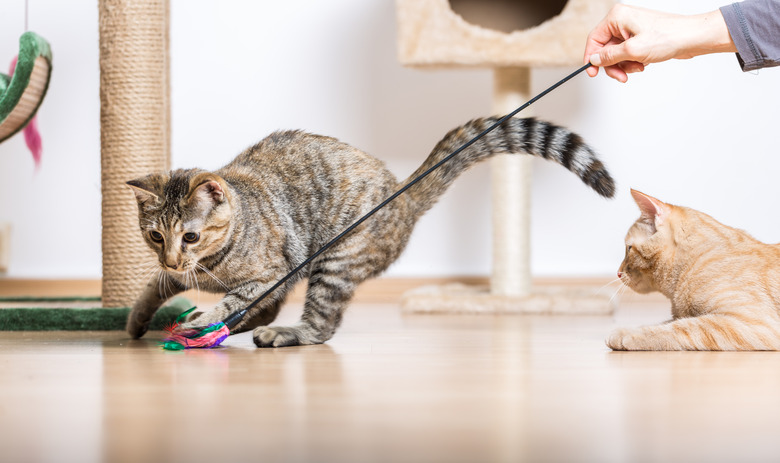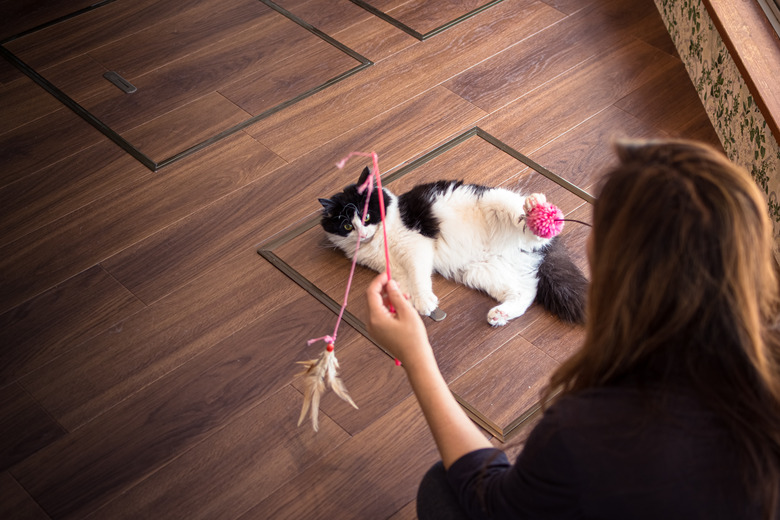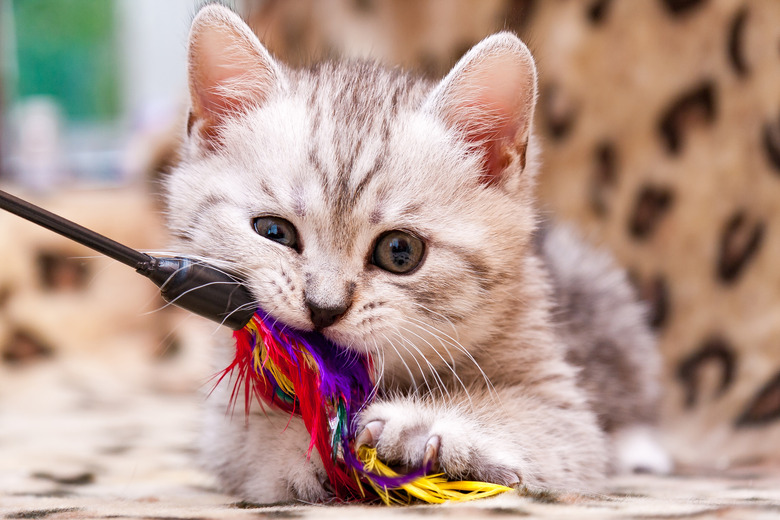How Much Should You Play With Your Cat Each Day?
We may receive a commission on purchases made from links.
Disclosure: At Cuteness, we are committed to being the go-to resource for pet owners and animal lovers. We only recommend products we think our audience will love. If you purchase something by clicking on one of these links, we may receive a small commission of the sale and the retailer might receive some data for accounting purposes.
Born to be an athletic huntress, your cat thrives on the pursuit of prey, which for our domestic indoor cats most often translates into the pursuit of play. And short of chasing robotic vacuum cleaners, you are nominated for the interactive role of prey "operator" to fulfill your cat's hunting instincts. Here's where your ingenuity shines.
How much play does your cat need?
How much play does your cat need?
Whether you entertain her with laser pointers, ping pong balls or rolled-up balls of paper, you should play with your cat each day ideally in two 15-minute play sessions — kittens and young adults will enjoy even more play sessions. This daily half-hour of fun is a rewarding bonding experience and essential for your cat's emotional and physical health, says Pam Johnson-Bennett, a prominent cat behavior expert and best-selling author of "Think Like a Cat."
Types of cat toys
Types of cat toys
In the wild, cats spend about 30% of their time hunting. Wand toys are a well-loved type of toy that can take your indoor cat through the entire prey sequence, which includes staring, stalking/chasing, pouncing/grabbing, then performing a kill bite, says Dr. Marci Koski of Feline Behavior Solutions. Buy them ready-made or make any number of variations of the wand toy yourself; for example, tie ribbons or feathers to the end of a stick or wooden dowel.
Pet stores such as PetSmart have the widest variety of cat toys. And there is such a variety! Popular items at PetSmart include the 5-star rated Whisker City Natural Fish Teaser. A classic wand-style toy, this is one you can hold and let your cat stalk, pounce, and grab. If your cat likes to chew, and they like catnip, try the catnip-infused Whisker City Pineapple Catnip Dental Chew that cleans their teeth and freshens breath. Kong toys are perennially popular with dogs, but Kong makes cat toys too! The Kong Refillables Squirrel Toy is a soft toy with an internal pouch for catnip. Laser toys are always popular. Try the Whisker City Laser and Clip Cat Toy that gives your cat an ever-moving target with pulse, strobe, and steady light displays. Sometimes, your cat wants to play but you don't want to have to hold a wand toy. Many cat toys have battery-operated motions. A good choice is the Petlinks Mystery Motion Electronic Motion Cat Toy. This toy offers a concealed toy mouse on a wand that spins around under a sheet that rustles, with four speed motions for unpredictable variety.
DIY cat toys to keep your cat engaged
DIY cat toys to keep your cat engaged
Since hunting is in your cat's DNA, toys that keep your cat engaged will mimic prey, like mouse look-a-likes and feather wand toys, for example. But if you are actively playing with your cat every day, commercial cat toys are going to wear out quickly or disappear altogether and need to be replaced. For the budget-conscious, do-it-yourself cat toys are the answer. Yes, playing with your cat can be super-easy and convenient at any time of day when you have a few tricks up your sleeve.
Most cats can't resist the magical lure of catnip. Making your own catnip toys is a smart way to recycle old socks, clothing, and bedding. Wash and dry your items and cut the fabric into squares or cut the toe end out of a sock, fill the center/bottom with dried catnip, pull the corners/top together, and tie the neck of the catnip purse tightly with string.
You can get crafty, embracing Martha Stewart's style, and make fancy toys like feathers and bell cat toys, but even the most primitive, homemade creations will be appreciated by your cat. Old standbys like empty toilet tissue rolls attached to a string give a nod to the beauty of repurposing household items, and cardboard boxes simply need a few little cut-outs for a perfect cat fort where your cat can remain undercover launching his stealth attacks on string or a feather duster you flick and dangle outside his "windows."
Playing with your older cat
Playing with your older cat
Cats reach their senior years at about age seven. And, thankfully, due to advances in nutrition, veterinary medicine, and an indoor lifestyle, they often live well into their teens, or even twenties. Playing with your older cat for one 15-minute interval each day with a cat toy gives you a relaxing break from your busy day while keeping your senior feline fit and happy. It's also an excellent opportunity to keep abreast of his physical, mental, and emotional condition as he ages.
Susceptible to the same problems humans experience as they age, older cats can develop arthritis, vision and hearing problems, dental issues and gum disease, and even dementia. Signs of these and a host of other age-related issues are likely to be most apparent during your interactive play sessions, giving you a heads up to consult with your veterinarian.
Normal signs of aging may include:
- Decrease in his once-boundless energy.
- Sleeping more.
- Less inclined to jump and climb.
- Generally slowing down.
- Weight gain.
If your older cat still runs after foil balls and laser pointers with youthful gusto, you might consider adding an extra play session each day, but even just one can put the spring back in an older cat's step.
Exercise and health
Exercise and health
Like people, cats reap powerful health benefits from exercise. Making the time in your day to provide a couple of 15-minute play sessions for your feline buddy not only enhances your relationship, but this special time together also improves a cat's mental acuity, and importantly, provides adequate exercise when practiced consistently.
In addition to exercise and playtime, keep boredom at bay by creating vertical spaces for your cat to explore, food puzzles, and consider clicker training among other enrichment opportunities, advises Koski.
References
- Cat Behavior Associates: Interactive Play Therapy for Cats
- Conscious Cat: How Much Exercise Should a Cat Have?
- Hills Pet: Common Problems With Aging Cats
- Amazon: Think Like a Cat
- World's Best Cat Litter: The 10 Best Homemade Cat Toys Your Cat Will Love
- Martha Stewart: How to Make a Cardboard Cat Playhouse
- Martha Stewart: Feather Cat Toy
- Clicker Training: Clicker Training for Cats


